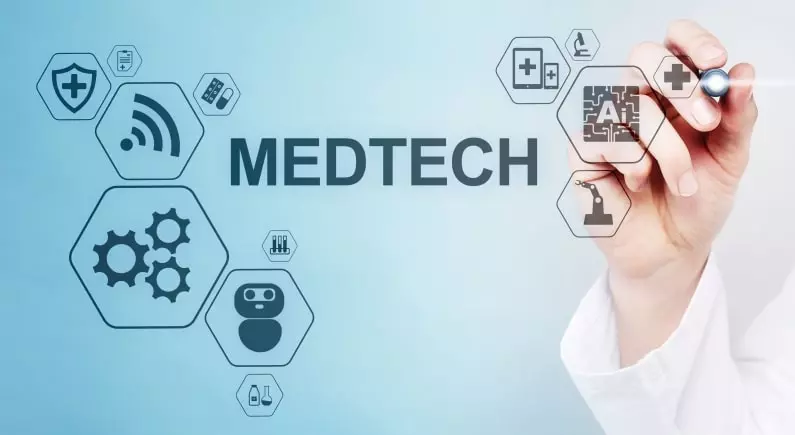By Dr. Meggie Mwoka

What is MedTech?
MedTech, or medical technology, involves the development, manufacture, and distribution of technologies, devices, equipment, diagnostic tests, and health information systems that enhance healthcare delivery. This sector is characterized by innovations such as rapid diagnostic tests, affordable fetal heart rate monitors and phototherapy machines, as well as the local production of essential consumables like syringes. The design, uptake and scale-up of these innovations is dependent on the specific needs of target populations, and health system capabilities to ensure accessibility and sustainability.
The MedTech Landscape in Africa
Africa is at a critical juncture in its healthcare journey, where the convergence of technological advancements and entrepreneurial ingenuity promises to revolutionize the medical landscape. With a staggering 20% of the global disease burden and only 3% of the global health workforce, the continent faces unique challenges that demand innovative solutions. The burgeoning medtech sector in Africa, encompassing everything from diagnostic devices to health information systems, is poised to address these disparities, offering hope for a healthier future.
Addressing Healthcare Challenges
Africa grapples with significant healthcare challenges. With only 0.2 physicians per 1000 people compared to the WHO recommended number of 2.5, access to quality healthcare is a significant issue.
Rural areas and poorer households are particularly disadvantaged. In most African countries, more than 90% of the medical devices in public hospitals are imported, with very limited local production. Many imported devices are ill-suited for the African context, being expensive, complex, and difficult to maintain- highlighting the need for locally relevant medical devices.
These challenges have sparked a wave of innovation across the continent. Startups are developing cost-effective solutions in prevention, diagnosis, treatment, and care, as well as improving health systems and supply chains. This vibrant ecosystem is addressing the continent’s unique healthcare needs through locally adapted technologies.
Market Dynamics
The revenue of the African medical devices market is expected to reach $ 9.61bn in 2024 and grow to $12.58bn by 2028, at a compound annual growth rate (CAGR) of 6.96% (Statista, 2024). This growth is driven by increase in chronic diseases (diabetes, hypertension, and cardiovascular condition), demand for real-time diagnostic testing for infectious and chronic disease, an aging population, advancements in biotechnology, and a rising demand for better healthcare. Cardiology devices dominate the market, projected to reach USD 1.43 billion by 2024 and diagnostic imaging devices USD 1.04 billion.
Barriers to Entry
Medtech startups in Africa face several barriers:
Regulatory Hurdles: Obtaining market approval for new devices and therapies is often a lengthy and expensive process. Post-market surveillance and the lack of standardized approval mechanisms across multiple jurisdictions add to the challenges.
Funding Challenges: Funding for MedTech startups requires ‘patient’ capital due to the extensive research and development, regulatory approvals, and rigorous trials needed to guide product development. These startups must also test and validate their business models to ensure successful commercialization. This lengthy and capital-intensive process can deter investors who seek quicker returns, creating a significant funding gap that innovative financing approaches need to address.
Market Perception: Locally manufactured devices often compete with imports and face perceptions of inferior quality, making market penetration difficult.
Seizing Opportunities
Investment Strategies: A blended capital approach, combining public, private, and philanthropic funding, is essential. Grants play a crucial role in early-stage product development, while equity investments are necessary for commercialization. Corporate venture capital can provide startups with access to established distribution networks and customer bases, enhancing credibility and market reach.
Partnerships: Strategic partnerships are crucial for scaling innovations. Collaborations between industry, academia, and government can support technological transitions. Partnerships with big pharmaceuticals and academic institutions can provide resources, expertise, and credibility. Moreover partnerships with implementing organizations such as NGO, can provide opportunities to further understand the market needs and opportunities for entry and scale.
Regulatory Harmonization: Strengthening regulatory frameworks is vital. The Africa Medical Devices Forum and the Africa Medical Regulatory Harmonization Consortium are working to streamline regulations and establish a continent-wide regulatory agency. It is anticipated that such initiatives will facilitate easier approval and market entry of medical devices across the continent.
Conclusion
The medtech sector in Africa is on the cusp of a transformative journey. By overcoming regulatory, funding, and market barriers, and seizing opportunities through strategic investments and partnerships, the continent can build a robust healthcare ecosystem.

Villgro Africa, in conjunction with Jaza Rift and other partners, launched the first Medtech Conference in Nairobi in 2023 and had the 2nd Transforming Africa Medtech Conference (TAMC) on August 28th-30th, 2024. This has created a pivotal platform to engage, discuss, challenge, and share insights on the future of medical technology in Africa, aiming to build a comprehensive and transformative vision for the African medtech industry, fostering collaboration and innovation.
Africa’s medtech revolution is not just about technological advancements; it’s about ensuring equitable access to quality healthcare for all. As the continent continues to innovate and grow, it is poised to redefine global health dynamics, offering sustainable and effective healthcare solutions tailored to its unique needs.
Tune in for part 2 of the medtech publication series as we explore a case study of the Kenyan medical equipment industry.
References
- Africa Medical Devices Market Overview: https://www.marketresearchfuture.com/reports/africa-medical-devices-market-2845
- Mohammed A Idris-Dantata H Okwor T et al. Supporting the manufacturing of medical supplies in Africa: collaboration between Africa CDC partners and member states. Glob Health Sci Pract. 2023;11(5):e2300121. https://doi.org/10.9745/GHSP-D-23-00121
- The Institute for Economic Justice. The Localisation Of Medical Manufacturing In Africa. 2022. https://www.iej.org.za/wp-content/uploads/2022/11/IEJ-LoMMiA-report_Nov2022.pdf
- W.Moses. From Obstacles To Opportunities: How Health Startups Are Redefining Healthcare In Africa. https://villgroafrica.org/from-obstacles-to-opportunities/
- Statista. Medical Devices-Africa. https://www.statista.com/outlook/hmo/medical-technology/medical-devices/africa
- 2023 Round Up: Investments in African Healthtech. A Review of 2023 Funding Activity. Salient Advisory. February 2024.
- World Health Organization. https://www.who.int/data/gho/data/indicators/indicator-details/GHO/medical-doctors-(per-10-000-population)
- WHO. The State of the Health Workforce in the WHO African Region. 2021: Brazzaville.
- WHO. Working Together for health. World Health Report 2006. Geneva.
- Niohuru, I. (2023). Disease Burden and Mortality. In: Healthcare and Disease Burden in Africa. SpringerBriefs in Economics. Springer, Cham. https://doi.org/10.1007/978-3-031-19719-2_3

